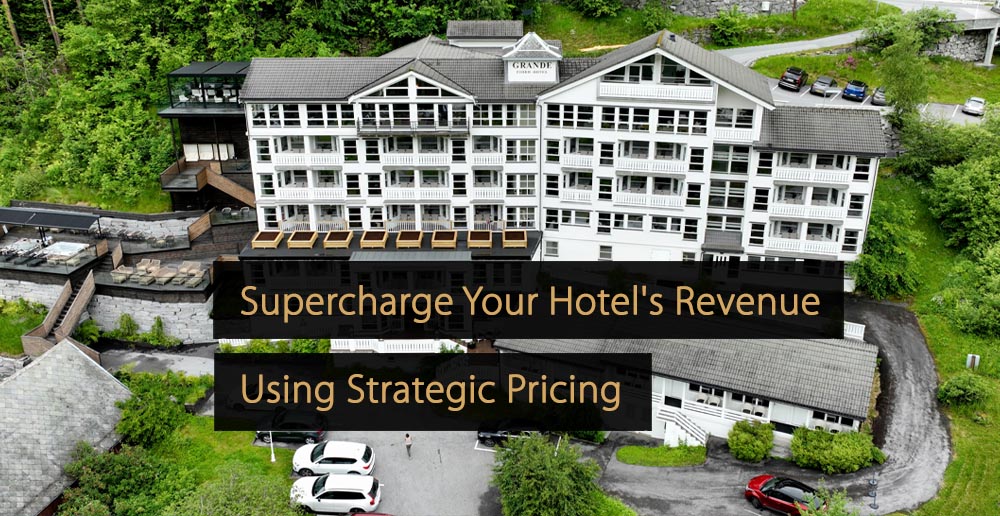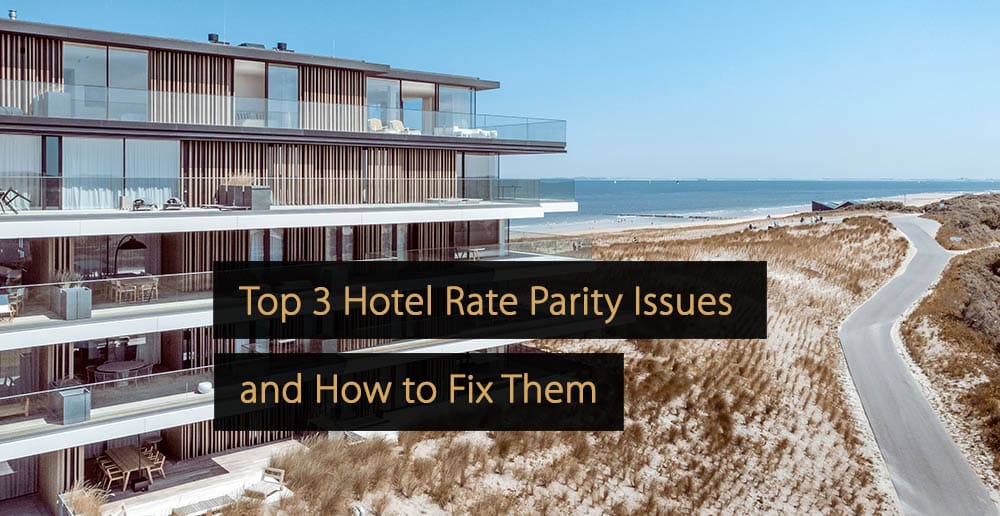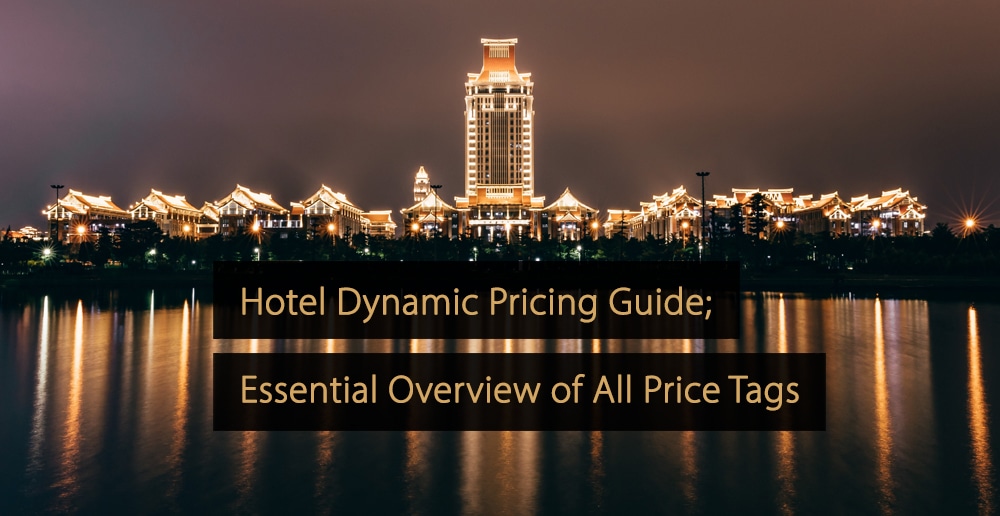In the hospitality industry, strategic revenue management allows hotels to achieve consistent profitability, no matter how the market changes. In revenue management, your goal is to fill rooms and maximize profitability on each booking in peak and off-peak seasons.
Strategic Pricing to Increase Your Hotel’s Revenue
This article will teach you proven tactics to supercharge your revenue using strategic revenue management tactics.
1. The Case for Increasing Your Rates
Unlike what most hoteliers think, setting your room rates higher than the competition can help you earn more overall profits. Potential guests can perceive a bold pricing strategy as a signal of quality and confidence, attracting guests willing to pay a premium for that perceived value. If your hotel consistently reaches high occupancy early on, this is a sign that your rates may be set too low and that you should increase your rates to increase your bottom line.
2. Occupancy Levels and Price Adjustments
Monitoring your occupancy levels provides critical insight into whether your pricing is set correctly, according to what the market will bear. If your hotel’s occupancy is lower than expected, you might be pricing your rooms above the market price; however, if you consistently have high occupancy, it’s a possibility that you’re pricing your rooms too low. Regularly tweaking your prices in response to these occupancy signals can help you find the best rate that maximizes occupancy and revenue.
3. The Psychology of Pricing and Dynamic Pricing Strategies
Dynamic pricing is critical for hoteliers’ success, especially in today’s constantly changing post-COVID market. While many hoteliers are worried that guests will react negatively to fluctuating prices, that isn’t true; in fact, a study by ZHAW University in May 2023 showed that guests adapt to, and even support, dynamic pricing when it’s based on supply and demand. Knowing this, you should use dynamic pricing to capitalize on high-demand periods and remain competitive during off-peak times.
4. The Risks of Overpricing and Underpricing
Strategic pricing is all about balance. Charge too much, and your hotel will upset potential guests and make them feel taken advantage of, leading to a tarnished reputation; on the other hand, setting prices too low can give guests the impression that your property is of lower quality, damaging your reputation. It’s essential to set your prices within a range that customers consider to be “fair,” according to the market, and the value they receive from their stay must align with the price they paid.
5. Discounting Strategies and Their Implications
Depending on the situation, discounting can be a positive or negative pricing strategy; it can drive occupancy, making you more attractive to potential guests on the OTAs, but it can also lead to a race to the bottom, eroding profit margins and disrupting rate parity. To leverage discounts effectively, it’s crucial to maintain control over the process, ensuring that discounts offered on OTAs are matched on your website and across all platforms. This prevents undercutting your direct sales channels and maintains consistency in pricing.
While I don’t recommend using discounting on the OTAs as a long-term solution, here is my best recommendation for how to maximize the benefits while minimizing risk:
- Use controllable OTA discounts, which you can replicate across all OTAs and your website.
- Use an automated pricing solution to counteract these discounts with commensurate increases.
- Consider using increased commission on quiet days to increase ranking on the OTAs.
6. Pricing Tactics for Approaching Booking Dates
Hotels often discount room rates as the booking date approaches to win last-minute bookings; while this strategy can be effective in the short term, it can be detrimental over the long term. Long-term discounting can undermine the perceived value of your rooms or negatively impact your pricing strategy. Monitor booking patterns and adjust prices to maximize revenue without devaluing your hotel.
7. Competitive Pricing Analysis
Monitoring your competitors’ pricing strategies, especially large hotels with a dedicated revenue management team (whose full-time job is strategic pricing), can provide valuable insights. These properties have the resources and the technology that enable them to monitor market trends closely and adjust their pricing in real time. By mimicking their pricing movements, you can indirectly benefit from their expertise and make more effective decisions about your rates.
8. The Role of Minimum Length of Stay (MLOS) Requirements in Revenue Management
Minimum length of stay (MLOS) requirements can be useful during periods of high demand, making it possible to capitalize on the increased demand without exceeding your desired maximum rate. MLOS requirements are a good way to balance high occupancy with high per-night revenue without alienating guests with over-the-top daily rates.
9. Revenue Management for Shoulder Nights and Group Bookings
If you are fully booked on Saturday night but not very busy on Friday or Sunday, what are your chances of being fully booked on Friday? Unless you reduce your rates for those days, the chances that guests will choose to book with you are reasonably low because many guests want to stay both Friday and Saturday nights. In this example, Friday and Sunday are “shoulder nights,” which can be very difficult to sell and result in a significant loss of income, so you need a strategy to manage them effectively.
There are two good ways to manage shoulder nights (and I suggest that you use both):
- Price: If Saturday is more popular than Friday, you should charge more for Saturday. This strategy encourages bookers for Friday only and puts off bookers for Saturday only; guests booking for both nights pay more on Saturday but less on Friday to break even. This strategy should result in more bookings for Friday night and fewer for Saturday (compared to your competitors).
- Minimum Length of Stay (MLOS) Requirement: The second way to manage shoulder nights is to set a two-day minimum stay requirement so guests must stay both Friday and Saturday or Saturday and Sunday.
The same logic applies when deciding on whether to accept group bookings; if they are looking to book most of your rooms for one weekend night only, you need to evaluate whether that is a good move, as it is then impossible for other guests to book for the whole weekend (which would earn you more revenue overall). Also, never offer groups free cancellation because if they were to cancel, you would be left with no guests for the whole period.
10. Free Cancellation Policies and their Implications on your Revenue
Offering free cancellation is attractive to guests but can be risky for hotels during peak times because if the guest cancels at the last minute, there may not be enough time to rebook it, resulting in lost revenue. It’s important to weigh the potential revenue loss against the benefit of attracting guests who value flexibility. In periods of high demand, you should eliminate free cancellation options to protect your revenue.
11. Overbooking Strategies
Overbooking can effectively compensate for no-shows and last-minute cancellations for larger hotels; however, smaller properties should approach overbooking cautiously. If you have a 10% cancellation rate with only 20 rooms then, on average, two rooms will remain empty; however, there is still a 13% chance that all the guests booked for a particular night will arrive. As such, if you overbook one room every night, approximately once a week, you will have to move a guest to another hotel.
You may decide it is worth it for the six extra bookings in the short term, but consistently overbooking will eventually impact your level of service and, therefore, your online reviews and perceived value to future guests. As such, we recommend that smaller hotels use overbooking as a pricing strategy very sparingly.
12. Using Strategic Room Upgrades to Increase Revenue
Strategically managing room upgrades can maximize occupancy and enhance guest satisfaction. By upgrading guests to higher-tier rooms, you can free up in-demand, lower-tier rooms, potentially leading to more sales and improved reviews (from guests who received the free upgrades). The first people to upgrade are repeat clients. Secondly, you should upgrade people who have booked directly with you. This policy should be explicitly stated on your website and in your booking engine, as it’s a great way to incentivize people to book directly.
14. The ‘Rule of Three’ in Pricing
Offer guests three different pricing options, each of which will be desirable to a certain type of guest, to simplify guests’ decision-making process and steer them towards the rate that’s most profitable for your hotel:
- The first price is the bargain, no-frills price. This is for people who are very price-sensitive and don’t mind mild inconveniences, such as non-refundable rooms, no breakfast or parking included, etc.
- The second price is what you want most people to book, so ensure that it offers a lot more value and makes you more money.
- The third price is considerably higher than the second, designed for guests who want the best and are not price-sensitive. Apart from earning you extra revenue, the other benefit of the third price is that it makes the second price look affordable (due to a cognitive bias known as anchoring, which encourages us to rely too heavily on the first piece of information we are given about a topic); customers will assume that the second option much better values and, as such, will be more willing to pay for it (even if it is priced higher than the “fair” price) because of how much higher the third price is.
Conclusion
In conclusion, strategic pricing requires a delicate balance between market demands, competition pricing, and guest valuations. Hoteliers can significantly increase their revenue by applying the tactics discussed in this article—from dynamic pricing to strategic discounting and room upgrades.
In a constantly changing hospitality landscape, staying ahead of the curve is not just about filling rooms; you should also focus on maximizing the revenue earned on each booking to contribute to a healthier bottom line. Either using the (manual) pricing tactics we discussed in this article or an automated pricing system like RoomPriceGenie, which will do all of the above automatically for you. The power to supercharge your hotel’s revenue is in your hands. Now, you must decide: What will you do with this power?
Free Ebook: 49 Tips to Supercharge Your Hotels Revenue
This free ebook consists of 73 pages with 49 tips to supercharge your hotel’s revenue. It has been expertly curated to help small hotels make the most of the online marketing, distribution, sales, and revenue management opportunities.
Click here to download the ebook “49 Tips to Supercharge Your Hotels Revenue”.







Leave A Comment